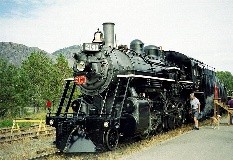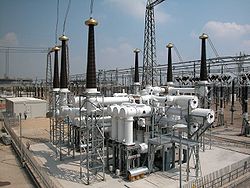A pipeline, railway or telecommunication cable (referred to herein as victim line) sharing a common corridor with ac power transmission or distribution lines captures a portion of the electromagnetic field energy surrounding the power lines in the air and soil. This captured energy, often designated as ac interference can result in an electrical shock hazard for people touching the victim lines or metallic structures connected to them or simply standing near them. Furthermore, excessive stress voltages across rails, telephone pairs or pipe walls and coating surfaces can result in degradation or damage to equipment and puncture of pipe coating, leading to accelerated corrosion and can damage insulating flanges and rectifiers. In the case of extreme soil potential rise, the pipeline wall itself can be damaged or punctured. Excessive rail-to-rail voltages (difference of potentials between rails) can compromise the normal operation of the signal and protection systems of the railways. Excessive induced power frequency noise in the telecommunication cables can degrade the signal quality of the cables.
Electromagnetic interference caused by electric transmission and distribution lines on neighboring metallic utilities such as oil, gas and water pipelines, railways and telecommunication cables has increased significantly in recent years. This is due to the tremendous increase in the load and short-circuit current levels that are the result of the growing energy demand. Another reason for increased interference levels originates from the more recent environmental concerns which impose on various utilities the obligation to share common corridors in an effort to minimize the impact on wildlife and other related threats to nature.
The cause and effect of ac interference from electrical power lines to adjacent utilities are well understood and the relative codes and standards are well documented. Several methods and software tools to analyze and compute the ac interference levels have been developed. Various mitigation techniques to reduce ac interference levels to the safe limits have been introduced and implemented widely. This document describes the essential methods and steps to carry out an ac interference study.
What follows is an outline of the objectives and tasks associated with a typical study of the electrical interference occurring in one or more victim lines due to their proximity to transmission lines which exist in the same corridor.
Objectives
The primary objectives of an interference study are as follows:
- Determine what mitigation is required to reduce victim lines potentials to less than a given maximum level throughout the right-of-way during worst case steady state conditions. This level is typically 15 volts, but can be as high as 50 volts in some areas or as low as 10 volts in others.
- Develop gradient control grid designs to protect exposed appurtenances, such as pipeline valve sites, during fault conditions, according to IEC Standard 479 or ANSI/IEEE Standard 80 safety criteria. Verify also that touch voltages at these installations are less than 15 volts during worst case steady state conditions. This requirement is set forth in NACE standard RP0177and CSA Standard C22.3 No. 6 - M1991. Cigré WG 36.02 Technical Brochure No.95, 1995 provides similar guidelines. For railways, AREMA standards or equivalent should be used. Similar standards apply for other types of victim lines.
- Determine the maximum stress voltages occurring during fault conditions along the victim lines. These stress voltages should not exceed prescribed limits. If necessary, design mitigation to reduce these stress voltages.
Project Tasks
The tasks involved in an interference mitigation design study are as follows:
Project Set-Up.
Data Collection and Review: Provide a detailed description of the data required for the study as soon as you are ready to perform the work.
Site Selection for Soil Resistivity Measurements.
On-Site Training of Group Making Soil Resistivity Measurements and Associated Preparation (if necessary): It is important that the measurement team fully understand the procedures that must be followed in order to obtain correct readings and troubleshoot any problems that might arise. They must use special equipment to filter out 50/60 Hz noise flowing in the earth or induced in equipment leads by the magnetic field surrounding the AC power line. They must also minimize inter-lead coupling and coupling between different pieces of equipment. Furthermore, they must avoid the influence of bare buried conductors. This requires suitable test equipment, correct measurement techniques, and constant monitoring of the readings for anomalies, so that rapid remedial action can be taken.
Soil Resistivity Measurements (by the trained group or qualified team).
Telephone/Fax Support of Team Making Soil Resistivity Measurements: This will be especially important during the initial days following the training, during which the team is likely to have questions. During this period also, the readings should be closely monitored for signs of trouble.
Interpretation of Soil Resistivity Measurements.
It is important that the soil resistivity measurements be resolved into multilayered soil structures so that conductive interference from faulted transmission line structures is properly computed in order that the necessary grounding and gradient control mitigation systems are designed in a safe and cost-effective manner.
Right-of-Way Model.
A detailed model including electric power lines, pipelines, railways, telecommunication lines and any associated facilities (e.g., power plants, substations) and grounding (e.g., sacrificial anodes, tower/pole grounding) should be created, in order to account for the interactions of all of these entities in the determination of inductive and conductive interference levels in the victim lines. It is important to include overhead ground wires, neutral conductors, other nearby metallic lines or conductors not explicitly under study as well as guy wire anchors connected to overhead ground wires.
Load Simulations.
During power line load conditions, magnetic field inductive interference constitutes essentially all of the interference present, once the victim line is constructed: the key concern here is victim line potentials (that lead to touch and step voltages and other possible equipment stress voltages). In the study of load conditions, it is important to consider possible phase unbalance. The influence of significant harmonic currents during steady-state conditions should be examined, if applicable.
Fault Simulations.
During fault conditions, conductive (through-earth) and inductive interference levels must be combined in order to compute victim line potentials, stress voltages and touch & step voltages. Faults should be simulated at representative intervals throughout the joint-use corridor (preferably at every transmission line structure, if possible) and currents injected into the earth by transmission line structures properly considered. Stress voltages and touch voltages at representative locations throughout the corridor length should be computed.
Power Plant and Substation Models.
The modeling of the skeletons of the grounding systems of any power plants or substations close to the victim lines under study may be necessary, for the estimation of through-earth transferred voltages during fault conditions. Power plants directly connected to the victim lines under study must also be modeled.
Mitigation Design: Gradient Control Wires.
This step determines the required extent of the gradient control wires in terms of zones along the exposed length. The particular characteristics of the mitigation wire elements in each zone should be determined as a function of the local multilayered soil model and interference levels: e.g., the number of wires required and whether any existing counterpoise conductors associated with transmission line structure grounding must be relocated or removed.
Gradient Control Grids for Exposed Appurtenances.
If required, grounding system designs should be elaborated for victim line appurtenances at which touch or step voltages remain excessive with gradient control wires added.
Final Report.
A letter report or a detailed, bound final report should be presented upon completion of the study. The key elements to be included are as follows:
- Tabulated multilayer soil structures from multilayer soil resistivity analysis.
- Graphs comparing measured apparent soil resistivity values with those generated by equivalent multilayer soils obtained from interpretation of the measurements.
- Plots of victim line potentials as a function of position along the corridor, for worst case load conditions, with and without the proposed mitigation.
- Plots of victim line potentials and stress voltages resulting from magnetic induction, as a function of position along the corridor, for all faults modeled, with and without mitigation.
- Plots of victim line touch and stress voltages resulting from the combined effects of conductive interference from nearby faulted transmission line structures and inductive interference, for representative sites, with and without mitigation.
- Perspective and plan-view plots of touch voltages associated with any gradient control grid design required for exposed victim line appurtenances.
A Typical Frequently Asked Question
How much time would be required to take the soil resistivity data over the entire 500 km of the pipeline and to acquire any other field data?
Also, It was mentioned somewhere that measurements should be taken at at least 100 m spacings or did I misunderstand? The pipeline will parallel and intersect 200 kv and 400 kv transmission lines for a considerable distance of the overall length. It also crosses a number of other pipelines in the same vicinity as the power lines.
The time required to measure the required soil resistivity data over the entire X km pipeline will depend on several factors, including the number of daylight hours during the measurement process, ease of site access, the weather, and the terrain. We have seen a team of two men completing two measurement sites per day, where each measurement site requires on the order of 15 measurements, at Wenner pin spacings varying between 0.5 m and 100 m (between adjacent pins). Sites are selected where particularly high levels of interference are expected, where exposed appurtenances are located and at intervals of 2 km or so within and near the interference zones, where the actual spacing required depends on the degree of uniformity of the soil structure along the length of the pipeline route.
Note that care should be taken in selecting the soil resistivity measurement equipment, in choosing the exact measurement traverse locations, and in taking the measurements, to insure satisfactory results. SES can provide support in this regard. No other field data is required provided that the drawings and data supplied by the gas and electric companies are complete and accurate. Collecting the data, however, should not be underestimated as a task, since data is frequently incomplete or unclear and requires further questioning or even field checks. Soil resistivity measurements are made over a considerable range of depths, as voltages transferred to the pipeline location by faulted transmission line towers or poles can be greatly influenced by deeper soil resistivities, as can the performance of long gradient control mitigation wires: as described in the paper transmitted to you previously, the soil layering can result in order-of-magnitude differences in conductive interference levels and mitigation performance. Having this data permits accurate modeling and, ultimately, cost-effective mitigation designs.
Computer Tools
SES recommends use of the CDEGS Software Package for the analysis and design work associated with an AC interference study. Click here for the decision tree.
Note that ECCAPP, a software package dedicated to AC interference studies and developed by SES for EPRI and A.G.A/PRC jointly, is based on older versions of the MALZ/TRALIN/SPLITS engineering software modules (1985 versions). At present, it can model only homogeneous soils, a serious limitation for the study of conductive interference in nonhomogeneous soils (order-of-magnitude errors can occur as a result).
Several other software packages currently used by some consultants are also based on uniform soil assumptions. Software packages exhibiting such limitations should be avoided.





